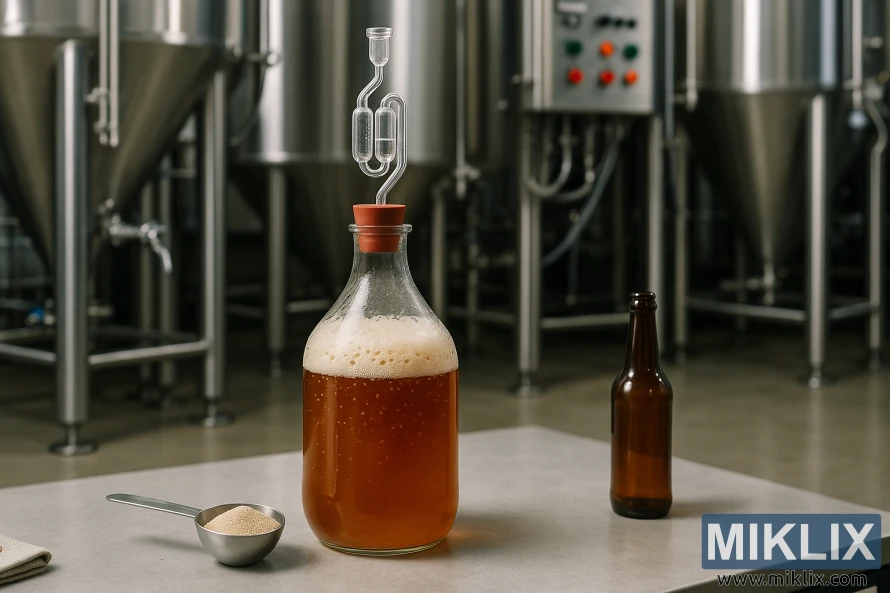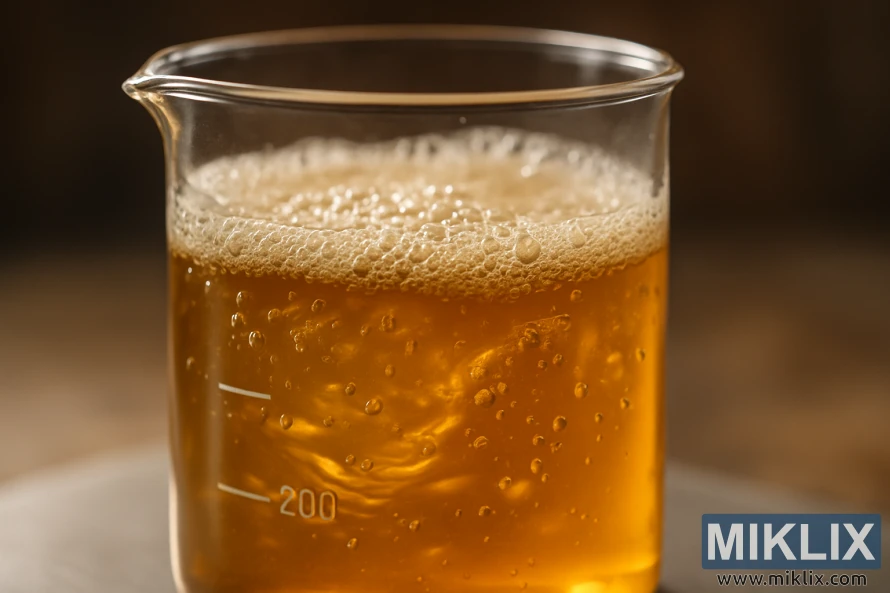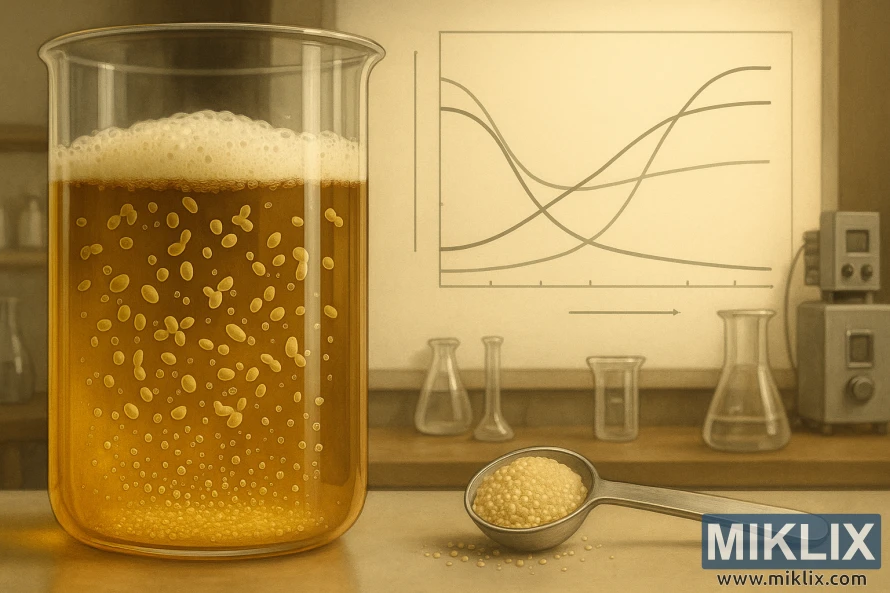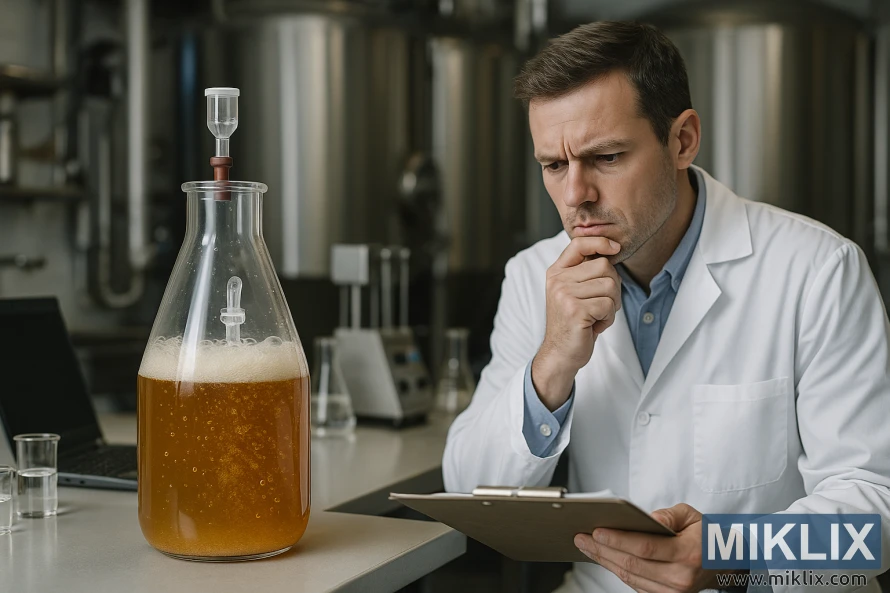Fermenting Beer with Fermentis SafLager S-23 Yeast
Published: August 18, 2025 at 7:47:17 AM UTC
Fermentis SafLager S-23 Yeast is a dry lager yeast from Fermentis, part of Lesaffre. It aids brewers in creating crisp, fruity lagers. This bottom-fermenting strain, Saccharomyces pastorianus, has its roots in Berlin. This strain is known for its pronounced ester character and good palate length. SafLager S-23 is a favorite among homebrewers and professional brewers for its clean lager with fruit-forward notes. It's perfect for fermenting lager in a garage or scaling up to a small brewery. Its dry lager yeast format ensures predictable performance and easy storage.

Key Takeaways
- SafLager S-23 is a Saccharomyces pastorianus strain designed for fruity, clean lagers.
- Available in 11.5 g, 100 g, 500 g, and 10 kg formats for hobby and commercial use.
- Ideal for fermenting lager styles where ester presence and palate length are desired.
- Dry lager yeast format simplifies storage and handling compared with liquid cultures.
- Article will cover pitching, temperature ranges, rehydration, and troubleshooting.
Introduction to Fermentis SafLager S-23 Yeast
SafLager S-23 is a dry, bottom-fermenting strain from Fermentis (Lesaffre), rooted in Berlin. It's a Berliner lager yeast known for adding controlled fruity and estery notes to traditional lagers.
This strain is classified as Saccharomyces pastorianus and is shipped as active dry yeast. It uses E2U™ technology, which dries cells to keep them dormant yet viable. This allows them to quickly reactivate when rehydrated or pitched into wort.
In terms of flavor, SafLager S-23 leans towards a fruit-forward profile while maintaining a clean palate length. It's ideal for fruitier lagers, hopped lagers, and any recipe where a modest ester expression is desired. This is over a neutral lager character.
Fermentis highlights the strain's robust performance across various practices. This includes cold fermentation and direct pitching without rehydration. Brewers looking for aromatic complexity often prefer S-23 over more neutral options like W-34/70.
- Background: Berliner lager yeast developed for lager brewing.
- Format: Active dry Saccharomyces pastorianus with E2U™ preservation.
- Use cases: Fruit-forward lagers and aromatic, hoppy lagers.
SafLager S-23 is part of the broader SafLager line-up. It includes strains like W-34/70, S-189, and E-30. This gives brewers a variety of ester profiles and attenuation behaviors for different lager styles.
Key Technical Features of SafLager S-23
SafLager S-23 is a Saccharomyces pastorianus strain, enhanced with emulsifier E491 for easier rehydration and handling. It ensures consistent performance in lager fermentations, meeting high viability and purity standards. The yeast count is above 6.0 × 10^9 cfu/g, and purity exceeds 99.9%.
The apparent attenuation of 80–84% offers brewers a reliable estimate of residual sugars. This range aids in planning the mouthfeel and final gravity for standard-strength lagers.
This strain is known for its higher ester production and alcohol tolerance. SafLager S-23 produces more total esters and superior alcohols than neutral lager strains. This contributes a mild fruity character when desired.
Alcohol tolerance is designed to fit typical brewery ABV ranges. Use it within standard-strength lager limits to ensure yeast health and flavor balance.
Sedimentation and flocculation follow the typical bottom-fermenting lager patterns. This allows for good settling after fermentation and easier clarification. Practical benefits include clearer beer and simpler transfer to conditioning tanks.
Microbial contaminant limits are stringent: lactic acid bacteria, acetic acid bacteria, Pediococcus, total bacteria, and wild yeast are all controlled to very low cfu ratios per yeast cell counts. Regulatory testing adheres to recognized microbiological methods such as EBC Analytica 4.2.6 and ASBC Microbiological Control-5D.
- Species: Saccharomyces pastorianus
- Viability: > 6.0 × 109 cfu/g
- Apparent attenuation: 80–84%
- Alcohol tolerance: suitable for standard-strength lagers
- Ester production: higher total esters and higher alcohols vs neutral strains
Recommended Fermentation Temperatures and Dosage
Fermentis suggests a dosage of 80–120 g per hectoliter for standard lager fermentations. For a gentle, slower process with lean ester profiles, opt for the lower end. The higher end is best for faster attenuation and tighter control.
The target temperature for primary fermentation is 12°C–18°C (53.6°F–64.4°F). Starting lower can help suppress ester formation. A programmed ramp after the first 48–72 hours aids in completing attenuation while preserving flavor.
- For delicate lagers: start at 12°C, maintain for 48 hours, then raise to 14°C as a controlled ramp.
- For fuller ester expression: begin nearer 14°C and hold within the 14°C–16°C range.
- For fast kinetics and high attenuation: use dosage S-23 at the upper range and ensure adequate oxygenation to match the pitching rate.
The pitching rate should align with wort gravity and production goals. A conservative rate reduces yeast stress in high-gravity worts. For heavier worts, increase the rate to avoid sluggish starts and excessive ester formation.
Fermentis internal trials followed a protocol of 12°C for 48 hours then 14°C for many SafLager strains. Brewers should conduct a pilot fermentation to validate performance with their specific wort, equipment, and process control.
Adjust dosage S-23 and pitching rate based on trial results. Monitor attenuation, diacetyl reduction, and sensory profile. Make incremental changes between batches to converge on the desired lager character.
Direct Pitching vs Rehydration Methods
Fermentis dry yeasts are made with E2U technology. This technology allows brewers to choose their pitching methods. It supports robust use at cold temperatures and under no-rehydration conditions. This makes both workflows suitable for commercial and homebrewers.
Direct pitching SafLager S-23 is straightforward. Sprinkle the dry yeast across the wort surface at or above the intended fermentation temperature. Do this as the vessel fills to ensure even hydration. Progressive sprinkling prevents clumping and ensures uniform dispersion.
Rehydration S-23 involves a more traditional approach. Measure at least ten times the yeast weight in sterile water or cooled boiled-and-hopped wort at 15–25°C (59–77°F). Rest the slurry for 15–30 minutes, then stir gently until it becomes creamy. Pitch the cream into the fermenter to reduce osmotic shock.
Each method has its advantages. Direct pitching SafLager S-23 saves time and matches Fermentis recommendations for maintaining viability and fermentation kinetics. Rehydration S-23 offers extra control over initial cell health and dispersion, which some breweries prefer for batch consistency.
When choosing pitching methods, consider sanitation, sachet integrity, and brewing scale. Ensure sachets are not damaged. Maintain clean equipment and consistent temperatures. Both direct pitching SafLager S-23 and rehydration S-23 deliver reliable results with good hygiene and proper handling.
- Direct pitching SafLager S-23: quick, fewer steps, supported by E2U technology.
- Rehydration S-23: reduces osmotic stress, promotes even starter formation.
- Choose based on brewery practices, equipment, and batch consistency goals.

Using SafLager S-23 for Different Lager Styles
SafLager S-23 is ideal for lagers that benefit from fruity complexity. It promotes ester production, making it perfect for Berliner lager yeast and other styles that enjoy bright, fruity notes.
For fruity lagers, ferment at the upper end of the recommended temperature range. This approach enhances banana, pear, and light stone-fruit esters without introducing off-flavors. Start with small batches to determine the optimal wort gravity and pitching rate.
Hop-focused beers benefit from S-23 when aiming for enhanced hop aroma and variety. This yeast allows hop oils and esters to interact, enriching the palate and amplifying varietal character. Be cautious with dry hopping to maintain balance.
For a cleaner, crisper lager, reduce the temperature and consider a neutral strain like W-34/70. For more expressive lagers, ferment slightly warmer, accepting a bit more ester presence. Small-scale trials are essential to fine-tune mash profile, pitch rate, and maturation time.
- Try Berliner-style lagers with modest original gravity to let esters shine without masking acidity.
- Match hop selection to ester profile for layered aroma in hop-forward lagers.
- Conduct small-scale trials before scaling to commercial batches to refine schedule and attenuation.
Fermentation Management and Kinetics with S-23
Fermentis SafLager S-23 exhibits consistent fermentation kinetics within recommended ranges. Starting temperatures around 12°C, followed by a step to 14°C, align with lab trials. This approach fosters steady yeast activity. Cold starts help in controlling ester formation and slow down the fermentation process. A slight increase in temperature accelerates fermentation without introducing off-flavors.
Attenuation levels typically range from 80-84%. This range results in lagers with a clean finish and variable residual sweetness, influenced by the mash. Daily gravity tracking early in fermentation confirms the expected gravity drop towards terminal gravity.
The yeast's viability exceeds 6.0 × 10^9 cfu/g, ensuring vigorous fermentation with proper pitching rates. Adequate oxygenation at pitching and yeast nutrients for high gravity worts are essential. They help sustain yeast activity throughout the fermentation phase.
Temperature control is critical in lager fermentation. Aim for a range of 12–18°C to balance fermentation speed and ester control. A diacetyl rest, timed with gravity decline, involves a temperature increase. This promotes clean ester reduction and efficient attenuation.
Consistent fermenter practices are key to achieving reliable results. Progressive pitching in large tanks can prevent prolonged lag phases. Monitoring gravity and temperature allows for adjustments in rest timing and conditioning phases. This ensures optimal fermentation kinetics and yeast health.
- Monitor gravity twice daily during the first 48 hours to confirm active attenuation 80-84% expectations.
- Provide oxygen at 8–12 ppm dissolved oxygen at pitching for robust yeast activity.
- Plan a nutrient addition for worts above 1.060 to prevent stalled kinetics.
Keeping detailed records of batch parameters, ferment temperatures, and gravity progress is essential. These notes help refine lager fermentation management. They enable the reproduction of SafLager S-23's clean, well-attenuated character.

Flocculation, Conditioning, and Packaging Considerations
SafLager S-23 exhibits typical bottom-fermenting flocculation. After primary fermentation, the yeast settles well, contributing to clarity without the need for heavy filtration. A distinct krausen drop and clearer beer are expected after a short rest.
Before cold maturation, plan a diacetyl rest. Increase the temperature slightly towards the end of fermentation. This allows the yeast to reabsorb diacetyl, reducing off-flavors and improving stability for lager conditioning.
Lager conditioning benefits from extended cold storage. Weeks at low temperatures smooth out esters and refine the mouthfeel. Cold crash aids in sedimentation, complementing the flocculation SafLager S-23 offers.
- Confirm final gravity and diacetyl levels before packaging.
- Use filtration or fine finings if you need extra clarity for commercial lager packaging.
- Monitor microbial stability; proper maturation reduces contamination risk.
Packaging choices significantly impact shelf life. Proper sealing and sanitary handling are key to preserving the beer's profile developed during lager conditioning. Remember, ester character often softens with time in well-conditioned beer.
If you plan to harvest yeast for re-pitching, check its viability and health. Store opened sachets according to the manufacturer's guidance. Use sealed containers for packaged beer to limit oxygen pickup and maintain flavor.
Storage, Shelf Life, and Handling of Dry SafLager S-23
Adhere to E2U storage guidelines to ensure Fermentis SafLager S-23 performs optimally. The sachet displays a best-before date. Dry yeast has a 36-month shelf life from production, provided it remains unopened and stored properly.
For short-term storage, temperatures below 24°C are acceptable for up to six months. Beyond that, keep temperatures under 15°C to maintain viability. Briefly, up to seven days, cold storage can be skipped in emergencies.
- Opened sachets must be resealed, refrigerated at 4°C (39°F), and used within seven days.
- Discard any soft or damaged sachets; compromised packaging can reduce cell viability and allow contamination.
Effective yeast handling begins with clean hands and sanitized tools. It also involves controlled environments during rehydration and pitching. Fermentis benefits from Lesaffre’s industrial expertise, ensuring high microbiological purity and reliable fermentation activity.
Follow E2U storage guidelines and rotate inventory by best-before date. Proper storage and careful yeast handling are key to achieving consistent lagers. They also help preserve the expected shelf life of dry yeast.
Scaling Dosage and Making a Starter for Homebrewers
Begin with the recommended 80–120 g/hl of SafLager S-23, which translates to 0.8–1.2 g per liter. For a 5-gallon (19 L) batch, multiply the per-liter amount by the brew volume. This method provides a straightforward way to determine the yeast quantity for lager brewing at home.
For a 19 L batch, the calculation results in approximately 15–23 grams of SafLager S-23 as a starting point. Increase this amount for high-gravity beers or to expedite fermentation. This strategy ensures the yeast count aligns with the desired attenuation and flavor profile.
Those who prefer a dry yeast starter should rehydrate the packet in about ten times its weight in sterile water at 30–35°C. Allow the rehydration to rest for 15–30 minutes, then gently swirl. Use the yeast cream directly or step it up in a small wort starter to enhance cell count further.
Direct pitch homebrewers often find the scaled dosage adequate. Adjust the pitching rate based on the beer's gravity: more yeast for stronger lagers, less for lighter ones. Keep records to refine the amounts with each batch.
- Calculate grams from 0.8–1.2 g/L for your volume.
- Rehydrate with 10× weight water for a dry yeast starter.
- Step up with a small wort starter if extra cell mass is needed.
When increasing cell counts, use progressive pitches instead of one large step. This approach reduces yeast stress and improves vitality. Test a small trial fermentation to confirm attenuation and aroma before scaling up to a full batch.
Record temperature, starting gravity, and final gravity after each trial. These notes will help refine the yeast quantity needed for lager and improve your brewing process for future batches.
Quality and Safety: Purity, Contaminant Limits, and Manufacturer Practices
Fermentis quality begins with rigorous microbiological testing. This ensures viable yeast counts are above 6.0 × 10^9 cfu/g. It also guarantees SafLager S-23 purity exceeds 99.9%. These standards safeguard fermentation performance and predict attenuation and flavor outcomes.
Yeast contaminant limits are set for common brewery microbes. These include lactic acid bacteria, acetic acid bacteria, Pediococcus, and wild yeast. Each contaminant is kept below specific cfu thresholds compared to yeast cell counts. Analytical methods adhere to EBC Analytica 4.2.6 and ASBC Microbiological Control-5D for accurate detection.
Lesaffre production employs industrial-scale hygiene and quality controls. These measures are taken during propagation and drying to reduce contamination risks. The company documents processes for consistent lots and verifies performance after drying with the E2U™ label. This confirms fermentative vigor.
Regulatory compliance demands testing for pathogenic organisms in finished products. Fermentis quality records show routine screening and certifications that meet food safety rules. This testing reassures both commercial brewers and hobbyists about product safety.
When purchasing SafLager S-23, retailers and Fermentis distributors accept various payment methods. These include Visa, Mastercard, American Express, PayPal, Apple Pay, Google Pay, and Venmo. Credit card details are processed through secure gateways and not retained by merchants.
Practical brewers should monitor lot numbers and storage conditions. This preserves SafLager S-23 purity and ensures yeast contaminant limits are met. Good handling, timely use, and following rehydration or pitching guidelines maintain viability and consistent results.
Troubleshooting Common Issues When Using SafLager S-23
When troubleshooting SafLager S-23, start by checking the basics. Confirm pitching rate, wort oxygenation, and nutrient additions. Underpitching or poor oxygen can produce sluggish fermentation S-23 even in moderate gravity worts.
For sluggish fermentation S-23, verify the pitching rate against recommended ranges of 80–120 g/hl. Measure dissolved oxygen at pitching and oxygenate if levels are low. Add yeast nutrients for high-gravity worts. If fermentation stalls, raise temperature gently within the strain’s range to reactivate yeast activity.
Excessive esters or ester off-flavors often come from the upper end of the recommended temperature window. If you detect ester off-flavors, drop fermentation temperature and lengthen lagering and cold conditioning. Adjust pitching rate upward to reduce ester production on future batches.
Watch for contamination signs such as unexpected sourness, a persistent haze, pellicles, or off-aromas that don’t match the SafLager S-23 profile. These contamination signs signal a need for sanitary review. Check sachet integrity and consider microbial testing if off-character persists.
Viability loss can follow improper storage or expired sachets. Check the best-before date and storage history. Fermentis guidance suggests storage below 24°C for short term and cooler for longer life. Damaged or heat-exposed sachets often yield poor performance.
If re-pitching harvested yeast, monitor for mutation and contamination. Test viability and purity before multiple re-uses. Maintain clean handling and use proper sanitation to reduce the risk of off-flavors and contamination signs.
Practical steps in troubleshooting SafLager S-23 include a quick checklist:
- Confirm pitching rate and sachet integrity.
- Measure dissolved oxygen at pitching.
- Add nutrients for high-gravity worts.
- Adjust temperature to control ester off-flavors.
- Inspect for pellicles, unexpected haze, and sour notes.
- Test viability if re-pitching harvested yeast.
Use these checks to isolate causes and apply targeted remedies. Clear records of temperature, pitching, and storage will speed diagnosis and help prevent repeat problems with SafLager S-23.

Comparisons with Other SafLager and SafAle Strains
SafLager comparisons often focus on ester character, attenuation, and fermentation temperature. SafLager S-23 is known for its fruity, ester-forward profile and good palate length. It's a top choice for brewers aiming to create expressive lagers and hoppy lagers with complex aroma and mid-palate.
When comparing SafLager S-23 to W-34/70, a clear contrast emerges. W-34/70 is more neutral and robust. It's ideal for classic, restrained lagers where ester suppression and clean malt focus are key.
Comparing S-23 to S-189 and E-30 reveals subtle trade-offs. S-189 is known for its elegant, floral notes. E-30, another ester-forward option, is recommended for pronounced fruit esters in cold-fermented beers. These strains allow brewers to fine-tune specific floral or fruity touches.
SafAle differences are significant when switching between top- and bottom-fermenting yeasts. SafAle strains like US-05 or S-04 work well at warmer temperatures, creating distinct ester and phenolic profiles. In contrast, SafLager S-23 is a bottom-fermenting Saccharomyces pastorianus strain designed for cooler ranges and distinct lager qualities.
When selecting yeast, consider the desired flavor outcome, fermentation temperature range, and attenuation targets. S-23 typically attenuates around 80–84%, contributing to dryness and body control. Process preferences, such as direct pitching or rehydration, also influence strain choice and final beer character.
- When you want fruity esters and length: consider SafLager S-23.
- For neutral, traditional lagers: opt for W-34/70.
- To highlight floral or alternative ester profiles: test S-189 or E-30.
- When comparing ale vs lager behavior: review SafAle differences for temperature and flavor expectations.
Utilize SafLager comparisons and a detailed yeast selection guide to align strain traits with recipe goals. Small test batches are essential to see how each strain interacts with malt, hops, and process conditions before scaling up.
Conclusion
Fermentis SafLager S-23 is a versatile dry Saccharomyces pastorianus strain developed in Berlin. It comes in various pack sizes. This strain produces fruitier, estery lagers with a good palate length when used correctly. This summary highlights the strain’s character and its practical value for both craft breweries and homebrewers.
Follow brewing recommendations: dose 80–120 g/hl and target fermentation temperatures of 12–18°C. Decide between direct pitching or rehydration based on your facility’s workflow. The E2U™ process supports robust activity in either approach. Remember to store it up to 36 months under specified temperature limits. Always maintain hygienic handling to protect yeast purity.
Run pilot trials to dial in pitching rate and temperature for your specific recipe. Monitor fermentation kinetics and conditioning to tune ester balance and final palate. Use Fermentis’ technical data sheet for lab-derived parameters. Adhere to manufacturer purity and handling guidelines for consistent results when fermenting lager yeast with SafLager S-23.
Further Reading
If you enjoyed this post, you may also like these suggestions:
- Fermenting Beer with White Labs WLP036 Dusseldorf Alt Ale Yeast
- Fermenting Beer with Fermentis SafLager S-189 Yeast
- Fermenting Beer with Wyeast 2002-PC Gambrinus Style Lager Yeast
